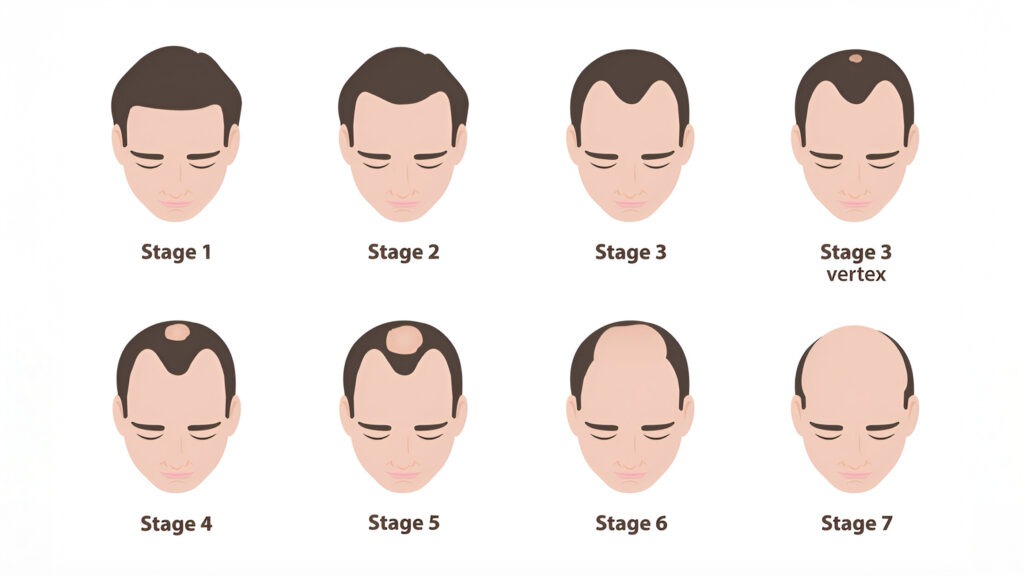For most men, a full head of hair isn’t just about appearance, it’s about identity, confidence, and self-image. Hair transplants have gained popularity across the globe with genetics, ageing, and lifestyle stress factors contributing to male pattern baldness being some of the most popular remedies. However, there is one question that every patient questions before entering a clinic, how many grafts do I really need? When it comes to a hair transplant on men, it is important to know about graft calculation, methods, prices and success rates. This blog is a summary of all you need to know, starting with graft requirements, including attaining the natural results that hair transplant men seek.
The Popularity of Hair Transplants in Men
In men, hair loss can usually start in the late 20s, or early 30s, and advances as they age. Androgenetic alopecia (male pattern baldness) is the most frequent form and approximately 50% of men have it by 50 years. Conventional interventions such as hair fibres, wigs, or drugs (minoxidil and finasteride) can provide a short-term solution but do not provide a lasting solution.
This is the reason why the best hair transplant for men is gaining ground- it replenishes hair with your own follicles giving a long-lasting and natural result.
What are Hair graft?
It is best to first establish what a graft is.
- A hair graft is a micro-block of tissue harvested out of the donor region (most often the back or sides of the head) and includes 1 -4 hair follicles.
- A graft of any size can produce several strands of hair. As an example, 2000 grafts can be translated into 4000-6000 real hairs.
- It is this difference that causes the number of grafts to be so important; it directly influences the coverage and density following the transplant.
Factors That Decide How Many Grafts You Need
All men lose their hair differently, and thus there is no universal solution. Graft requirements are calculated by surgeons according to:
Degree of Baldness (Norwood Scale)
- To categorise male pattern baldness, the Norwood scale (I to VII) is the universal one.
- Early onset (Norwood II -III) will require fewer grafts than late baldness (Norwood VI-VII).
Donor Hair Availability
- The back and sides of the scalp serve as the permanent donor zone.
- The thick donor density of men enables men to have better coverage using fewer grafts.
Desired Density
- Men desire a discreet reconstruction, and others desire the highest density to appear young.
- The natural-looking density is usually prescribed to 3550 grafts per cm 2.
Hair Characteristics
- Higher density, curly or darker hair takes less amount of grafts to provide coverage than thin, straight or light-colored hair.
Hairline Design
- A conservative mature hairline requires fewer grafts to re-create as opposed to a low, dense, youthful hairline.
Graft Requirements by Baldness Grade

To show you better, here is a rough graft range as indicated by the Norwood scale of baldness:
- Norwood II–III (Early Hairline Recession): 800–1500 grafts
- Norwood III Vertex (Thinning Crown): 1200–1800 grafts
- Norwood IV (Receding Hairline + Crown Loss): 2000 2500 grafts.
- Norwood V (Extensive Balding in Front + Crown): 2500–3500 grafts
- Norwood VI (Almost Full Top Baldness): 3500–4500 grafts
- Norwood VII (Severe Baldness): 5000–6000+ grafts (if donor allows)
These figures are rough figures. A personalised meeting with an accomplished surgeon will provide the precision of the graft count required in your case.
Why Graft Number Matters?
Many men ask: Why can’t I simply have as many grafts as possible at once? The truth is:
- The donor area is limited: Excessive harvesting may cause thinning or patches to be unnatural patches in the donor area.
- Quality over quantity: Position and angle, and dispersion are more important than over-gifting grafts.
- Natural aesthetics: The strategic design will give you a natural hair transplant that men can be proud of without the plugged or wig appearance.
Hair Transplant Techniques and Their Role in Graft Usage
Different surgical methods influence graft survival, recovery, and results. Let’s compare:
1. Follicular Unit Extraction (FUE)
- Grafts are harvested separately with micro punches.
- Minimally invasive, no linear scar.
- They are also perfect for men who prefer to be flexible in wearing short hairstyles.
- Good for small to medium bald spots.
2. Follicular Unit Transplantation (FUT/Strip Method)
- The donor region is stripped of a strip of scalp and grafts are excised by microscopic dissection.
- Yields a large number of grafts in one session.
- Produces a linear scar, which is frequently concealed by hair.
- Appropriate for males who have extensive baldness that requires 3000 or more grafts.
3. Advanced Methods (DHI, QHT, Sapphire FUE, etc.)
- Grant greater accuracy, reduced trauma and better graft survival.
- Formulated to provide men with the best hair transplant that heals faster and with a more natural appearance.
How to Estimate Your Graft Requirement?
This is the simplified procedure that surgeons have to adhere to:
- Scalp Analysis: Evaluate the degree of baldness with the Norwood scale.
- Density Check: Review the density of donors (mean is 60 -100 follicular units per cm 2).
- Measurement of Area: Measure the bald area (in cm 2 ) to determine graft requirement.
- Planning Hairline: Decide what hairline you would use that would match your age, face, and purpose.
- Final Estimate: Surgeons then propose a realistic graft range between the supply of a donor and the desired outcome.
Achieving Natural Results: The Surgeon’s Art
An effective male hair transplant is not about the numbers but art. Skilled surgeons focus on:
- Angle/Direction: Each graft is positioned in such a manner that it resembles the actual hair growth.
- Zoning: When the hair line is thick, the density pulls out to the front, becomes medium in the middle then it goes to light at the crown so it transitions to the hair line.
- Single-Hair Grafts Hairline: To give a natural, smooth appearance.
- Gradual Density: It does not produce sudden density variations between hair transplanted and existing hair.
It is this painstaking technique that produces natural effects that hair transplant men desire.
How Many Sessions Do You Need?
- Small bald patches (under 2000 grafts): Usually 1 session.
- Moderate baldness (2500–3500 grafts): Sometimes 1 long session or 2 sessions.
- Advanced baldness (4000+ grafts): The sessions are normally 2 sessions with a spacing of 6 to 12 months.
This depends on the supply of donors, the laxity of the scalp, and the ability of the patient to recover.
What to Expect in Hair Transplant Cost for Men?

The hair transplant cost for men is quite diverse depending on the country, the reputation of the clinic, the experience of the surgeon, the technique, and the number of grafts.
Cost Factors:
- Grafts: The majority of the clinics are charged per graft.
- Methodology (FUE, FUT, DHI, etc.).
- Clinic & surgeon reputation.
- Support services (anaesthesia, aftercare, follow-ups).
Approximate Global Ranges (per graft):
- India: $0.40 – $1.00 (Affordable, high-quality care)
- Turkey: $1.00 – $2.50
- UAE: $2.50 – $4.00
- USA/UK: $3.00 – $8.00
Example: The price of a hair transplant for men can be between 1,200 dollars in India and 15,000 dollars in the US in the case of 3000 grafts.
The Best Hair Transplant for Men: Choosing Right
Men need to consider the following factors to choose a clinic successfully:
- Board-Certified Surgeons: Be sure that the surgeon has a background in FUT and FUE.
- High Graft Survival Rate: The clinic with good results gives 90-95 per cent graft survival.
- Modern Technology: Developed extraction and implantation equipment to minimise trauma.
- Before & After Gallery: realistic patient outcomes demonstrate the dexterity of the surgeon.
- Aftercare Support: Appropriate post-op care is the guarantee of the success of grafts.
Recovery and Results Timeline
- First Week: erythema, slight swelling, crusts about grafts.
- 2 -3 Weeks: The transplanted hair falls ( normal shock loss ).
- 3-4 Months: This is the start of new hair development.
- 6 Months: Noticeable improvement in density.
- 12 Months: Final results with natural density and volume.
- It is all a matter of patience- complete outcomes can take up to 12-18 months.
Hair Transplantation Tips For Men
- Start Early: Don’t wait until you are in Norwood VII; the sooner the better to save donor hair.
- Maintain with Medication: Finasteride and minoxidil can delay additional loss.
- Limit Yourself by making Realistic Goals: What you can do is limited by the supply of donors.
- Choose Experience over Expense: The ideal solution to having a hair transplant as a man is that which is aesthetically pleasing, safe, and ultimately successful.
- Commit to Aftercare: Follow instructions strictly for optimal results.
Final Thoughts
A hair transplant in men is not only about restoring the hair that has been lost, but also regaining confidence. Your graft quantity will vary with the level of baldness, density of the donor, and your preferred appearance. It is 1500 or 5000 grafts, but what really counts is the expertise of the surgeon, the method utilised and a strategy that has been strategised to look natural. When you want natural results hair transplant men are confident in what counts as experience, not the figures. It is important to remember that hair transplantation is a kind of investment in self-esteem and quality of life in men. Make the right decision and you will reap the benefits over the long run.

